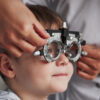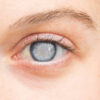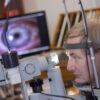Glaucoma is a leading cause of blindness worldwide, and World Glaucoma Week (taking place from March 12 to March 18) is an annual event aimed at raising awareness of this serious eye condition. Here, we take a closer look at what glaucoma is, how many people it affects, what the symptoms are, and how it is treated.
What is Glaucoma?
Glaucoma is a group of eye diseases that damage the optic nerve and lead to vision loss over time. It is caused by an increase in pressure within the eye, which can damage the delicate nerve fibres that transmit visual information from the eye to the brain. If left untreated, glaucoma can cause irreversible vision loss and even blindness.
Glaucoma is a life-long, chronic disease that cannot be cured. Any sight lost due to glaucoma cannot be regained. But the good news is, with effective medical treatment, the damage can be slowed or even stopped in its tracks.
Glaucoma was once a disease that would almost certainly lead to blindness. Huge advances in diagnosis, monitoring and treatment now mean that, in the UK, the vast majority of people with glaucoma will keep useful sight for life.
How Many People are Affected by Glaucoma?
Glaucoma is a widespread condition, affecting an estimated 80 million people worldwide. In England, about 480,000 people have chronic open-angle glaucoma but there will be many more unaware they have the condition. This is because glaucoma often has no symptoms in its early stages, which is why regular eye exams are so important.
Who is likely to get Glaucoma?
Anyone can develop glaucoma but there are several risk factors which make glaucoma more likely.
Age – Primary open angle glaucoma becomes more common with age. It’s fairly rare below age 40, but rises from about two in 100 over the age of 40 to more than one in 20 for those aged 80+.
Blood pressure – Very high blood pressure can lead to an increase in intraocular pressure. Low blood pressure can lead to insufficient blood supply to the optic nerve which can also cause problems.
Ethnicity – People of African-Caribbean origin have about a four-times higher risk of primary open angle glaucoma compared to those of European origin. People of east Asian origin are at higher risk of developing primary angle closure glaucoma.
Family history – There is at least a four-times higher risk of developing glaucoma if you have a close blood relative who has it. So, if you have glaucoma, you should tell your relatives about the condition as they may need to be tested.
Short sight – People with short sight (myopia) are at increased risk of developing glaucoma.
Long sight – People with long sight are at increased risk of developing primary angle closure glaucoma.
Diabetes – People with diabetes may be at higher risk of developing glaucoma.
What are the Symptoms of Glaucoma?
In the early stages of glaucoma, there are often no symptoms, which is why regular eye exams are so important. However, as the condition progresses, you may experience symptoms such as:
- Gradual loss of peripheral vision (the sides of your visual field)
- Tunnel vision
- Blurred vision
- Halos around lights
- Eye pain and redness
It is important to note that if you experience any of these symptoms, you should seek immediate medical attention as vision loss from glaucoma is irreversible.
How is Glaucoma Treated?
Treatment for glaucoma is aimed at reducing the pressure within the eye to prevent further damage to the optic nerve. The most common treatment options include:
Medications: Eye drops, pills, or injections can help reduce the pressure in the eye.
Laser therapy: A laser beam is used to create a small drainage hole in the eye, allowing fluid to drain out more easily and reducing pressure.
Surgery: In some cases, surgery may be necessary to improve the drainage of fluid from the eye and reduce pressure.
It is important to note that there is no cure for glaucoma, but early detection and treatment can slow the progression of the disease and preserve your vision.
What can TK&S Optometrists offer to glaucoma patients?
All the optometrists at TK&S are trained and understand how to thoroughly assess for glaucoma using the wide range of tools at our disposal. Dr Keyur Patel has a Diploma in Glaucoma from the College of Optometrists and runs a specialist clinic within the practice.
The TK&S Glaucoma Clinic provides hospital standard diagnostics and investigation for patients concerned or at risk from glaucoma.
This appointment includes;
- Comprehensive history
- Goldman Applanation Tonometry (gold standard for eye pressure measurement)
- Gonioscopy
- Dilated Biomicroscope Evaluation of the Optic Nerve
- Threshold Visual Screen Testing
- Triton OCT imaging for analysis of nerve fibre layers
- Pentacam – for a complete overview of the anterior eye segment and assessing angles
- Recommendations
Patients with ocular hypertension can be diagnosed and managed within this clinic.
If you, or a close family member, has been diagnosed with glaucoma then please get in touch to arrange an appointment at our specialist Glaucoma Clinic.





